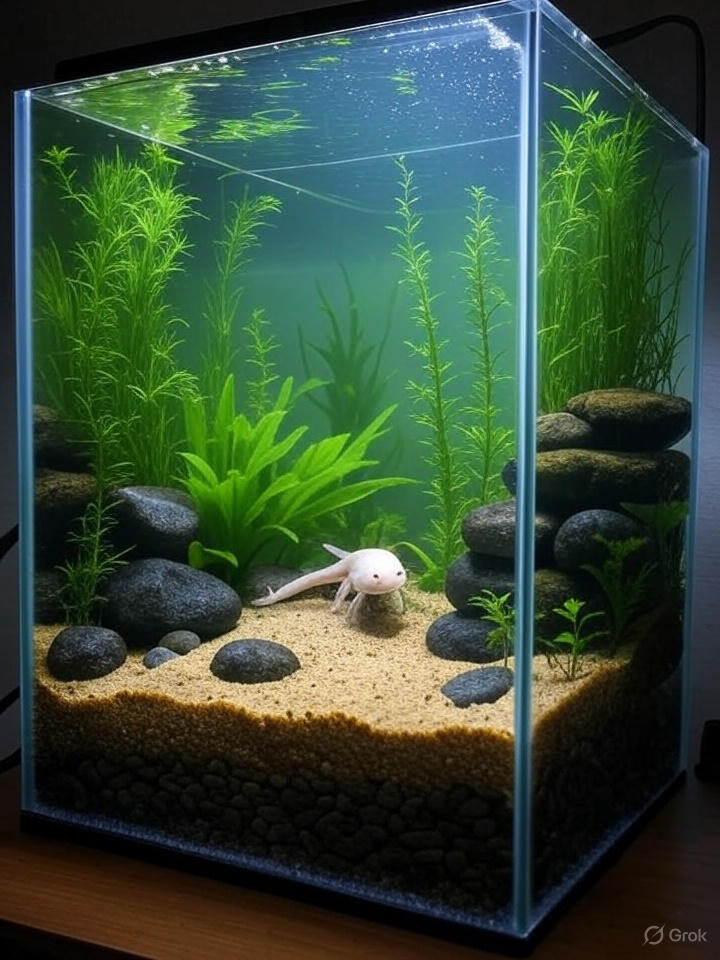The axolotl (Ambystoma mexicanum), often called the “Mexican walking fish,” has captured the hearts of aquatic pet enthusiasts worldwide. These remarkable creatures, which are actually salamanders rather than fish, have become increasingly popular as exotic pets due to their unique appearance and fascinating biology. Setting up the perfect axolotl tank requires careful consideration of their specific needs, from water parameters to tank size and filtration systems.
According to Wikipedia, axolotls are on the International Union for Conservation of Nature’s Red List of threatened species, making captive breeding and proper care even more important for conservation efforts. This comprehensive guide will walk you through every aspect of creating an ideal habitat for your axolotl, ensuring they live a healthy and comfortable life in captivity.
Understanding Your Axolotl’s Natural Habitat
Before diving into tank setup specifics, it’s crucial to understand where axolotls come from and what conditions they naturally thrive in. Axolotls are endemic to the lake system of Xochimilco, near Mexico City, Mexico. These ancient lakes provided cool, clean water with specific temperature ranges and water chemistry that we must replicate in captivity.
The natural environment of axolotls consists of shallow, cool freshwater lakes with muddy bottoms and abundant aquatic vegetation. The water temperature in their native habitat ranges from 59-68°F (15-20°C), which is significantly cooler than many tropical aquarium setups. Understanding these natural conditions is the foundation for creating a successful axolotl tank setup.
Essential Tank Requirements: Size Matters
Minimum Tank Size Considerations
The recommended axolotl tank size is at least 10 gallons, however, most experts recommend going up to at least 20 gallons for a single adult axolotl. However, bigger is always better when it comes to axolotl housing. A 40-gallon long tank (36″ x 18″ x 16″) is considered the gold standard for a single adult axolotl, providing ample swimming space and better water quality stability.
For multiple axolotls, add an additional 20 gallons per additional axolotl. The tank should be longer rather than taller, as axolotls prefer horizontal swimming space over vertical depth. A long, shallow tank better mimics their natural lake environment and provides more floor space for exploration.
Tank Shape and Dimensions
The ideal axolotl tank should be rectangular and relatively shallow. Avoid tall, narrow tanks as they don’t provide adequate surface area for oxygen exchange and don’t match the axolotl’s natural swimming patterns. A tank with a larger footprint allows for better territorial behavior and reduces stress between multiple axolotls.
Water Parameters: Getting the Chemistry Right
Temperature Control
Water should be kept at 60-68 degrees Fahrenheit to prevent stress or slow metabolism. Temperature is perhaps the most critical factor in axolotl care. These cold-water creatures cannot tolerate warm temperatures, which can lead to stress, decreased oxygen levels, and potentially fatal conditions.
Most homes maintain temperatures above the ideal range for axolotls, making cooling essential. Options include:
- Aquarium chillers (most effective but expensive)
- Cooling fans directed at the water surface
- Frozen water bottles rotated throughout the day
- Air conditioning the room housing the tank
pH and Water Hardness
Axolotls prefer slightly alkaline water with a pH between 7.4-7.6. The water hardness should be moderate, around 7-14 dGH. These parameters help maintain proper gill function and overall health. Regular testing with reliable aquarium test kits is essential for monitoring these levels.
Ammonia, Nitrite, and Nitrate Levels
Like all aquatic animals, axolotls are sensitive to nitrogen compounds. Ammonia and nitrite should always be at 0 ppm, while nitrates should be kept below 20 ppm through regular water changes and proper filtration. The nitrogen cycle is crucial for maintaining a healthy axolotl environment.
Filtration Systems: Keeping Water Clean and Oxygenated
Types of Filtration
Axolotls produce significant bioload, requiring robust filtration systems. A combination of mechanical, biological, and chemical filtration is ideal:
Mechanical Filtration: Removes physical debris and waste particles from the water. Use filter pads, sponges, or floss to trap solid waste.
Biological Filtration: Beneficial bacteria convert harmful ammonia and nitrites into less toxic nitrates. Established biological media like ceramic rings or bio-balls are essential.
Chemical Filtration: Activated carbon removes dissolved organics and odors, though it should be used sparingly and replaced regularly.
Filter Selection and Flow Rate
Choose filters rated for at least double your tank volume. However, axolotls prefer gentle water flow, so adjustable flow rates are crucial. Canister filters work excellently for axolotl tanks, providing powerful filtration while allowing flow control.
Hang-on-back filters can work but may create too much surface agitation. Internal filters are generally too weak for adequate biological filtration in axolotl tanks.
Substrate Choices: Safety First
Safe Substrate Options
Substrate selection is critical for axolotl safety. These creatures are known to gulp substrate along with their food, which can cause impaction if the substrate is too small to pass through their digestive system or too large to swallow safely.
Recommended Substrates:
- Fine sand (particles smaller than the axolotl’s head)
- Large river rocks (too large to swallow)
- Bare bottom tanks (easiest to clean)
Substrates to Avoid:
- Gravel (impaction risk)
- Small decorative stones
- Crushed coral
- Any substrate with sharp edges
Bare Bottom vs. Sand
Many axolotl keepers prefer bare bottom tanks for ease of cleaning and elimination of impaction risks. However, sand provides a more natural environment and allows for natural foraging behaviors. If choosing sand, ensure it’s fine aquarium sand specifically designed for bottom-dwelling creatures.
Lighting Requirements: Less is More
Axolotls are naturally nocturnal and prefer dim lighting conditions. Bright lights can stress them and encourage algae growth. If lighting is necessary for live plants or viewing, use low-intensity LED lights on timers to provide 8-10 hours of gentle illumination.
Red or blue spectrum lights can be used during evening hours to observe your axolotl without disturbing their natural behavior patterns. Avoid placing the tank in direct sunlight, which can cause temperature fluctuations and excessive algae growth.
Tank Decoration and Enrichment
Hiding Places and Shelter
Tanks should have plants and decorations to keep the axolotl comfortable and entertained. Axolotls need multiple hiding spots throughout the tank to feel secure. Suitable hiding places include:
- PVC pipes (4-6 inches in diameter)
- Terracotta pots (smooth edges)
- Commercial aquarium caves
- Driftwood pieces
- Live or artificial plants
Ensure all decorations have smooth surfaces to prevent injury to the axolotl’s delicate skin and gills.
Plant Selection
Live plants provide additional filtration, oxygen production, and natural environments. Suitable plants for axolotl tanks include:
- Java fern
- Anubias species
- Java moss
- Hornwort
- Water sprite
Avoid plants with sharp or rough leaves that could damage the axolotl’s sensitive skin.
Water Quality Maintenance
Water Change Schedule
Regular water changes are essential for axolotl health. Perform 20-25% water changes weekly, or more frequently if water parameters indicate higher nitrogen levels. Always use dechlorinated water at the same temperature as the tank water.
Water Testing Routine
Test water parameters weekly using reliable test kits:
- Ammonia (should be 0 ppm)
- Nitrite (should be 0 ppm)
- Nitrate (below 20 ppm)
- pH (7.4-7.6)
- Temperature (60-68°F)
Keep detailed records of water parameters to identify trends and potential issues before they become serious problems.
Feeding Considerations in Tank Setup
While tank setup focuses on the physical environment, consider feeding stations and waste management in your design. Axolotls are messy eaters, so easily accessible areas for waste removal are important.
Earthworms and night crawlers meet the nutritional requirements better than any other option, containing over 60% protein. Having designated feeding areas helps maintain water quality and makes waste removal more efficient.
Common Setup Mistakes to Avoid
Temperature Issues
The most common mistake is maintaining water temperatures too high. Many beginners assume axolotls need tropical temperatures like other aquarium pets. Investing in proper cooling equipment from the start prevents stress and health issues.
Inadequate Tank Size
Starting with too small a tank leads to water quality issues and stressed axolotls. While initial costs may be higher, proper-sized tanks provide better long-term outcomes for both pet and owner.
Wrong Substrate Choice
Using gravel or inappropriate substrates leads to impaction, one of the leading causes of axolotl mortality in captivity. Research substrate options thoroughly before setup.
Insufficient Filtration
Underestimating the bioload axolotls produce leads to poor water quality. Invest in appropriate filtration from the beginning rather than upgrading later.
Advanced Setup Considerations
Breeding Tanks
If interested in breeding axolotls, consider a separate breeding setup with specialized requirements. Breeding tanks need cooler temperatures (50-59°F) to trigger spawning behavior and specific egg-laying surfaces.
Quarantine Systems
Maintain a separate quarantine tank for new axolotls or sick individuals. This secondary system should mirror the main tank’s conditions but be smaller and easier to medicate if necessary.
Multi-Tank Systems
Experienced keepers often maintain multiple tanks for different purposes: growing out juveniles, housing incompatible individuals, or maintaining breeding colonies. Plan your space and filtration systems accordingly.
Setting Up Your Axolotl Tank: Step-by-Step Process

Phase 1: Planning and Preparation
- Choose appropriate tank size and location
- Purchase necessary equipment (filter, heater/chiller, test kits)
- Select substrate and decorations
- Plan aquascape layout
Phase 2: Initial Setup
- Clean tank and equipment thoroughly
- Install filtration system
- Add substrate (if using)
- Fill tank with dechlorinated water
- Install heating/cooling equipment
- Add decorations and plants
Phase 3: Cycling Process
- Begin nitrogen cycle with ammonia source
- Monitor water parameters daily
- Wait for beneficial bacteria establishment (4-6 weeks)
- Confirm zero ammonia and nitrite readings
Phase 4: Final Preparations
- Perform final water parameter check
- Adjust temperature to ideal range
- Add final decorations
- Prepare quarantine procedures for new axolotl
Maintenance Schedule and Long-term Care
Daily Tasks
- Check temperature
- Observe axolotl behavior
- Remove uneaten food
Weekly Tasks
- Test water parameters
- Perform water changes
- Clean filter media (if needed)
- Trim plants
Monthly Tasks
- Deep clean decorations
- Replace filter media
- Check equipment function
- Review and adjust feeding schedule
Conservation and Ethical Considerations
When setting up an axolotl tank, consider the conservation implications of your hobby. According to the International Union for Conservation of Nature’s Red List of Threatened Species, the axolotl is listed as critically endangered, with fewer than 1,000 specimens remaining in the wild.
Responsible axolotl keeping includes:
- Purchasing from reputable breeders rather than wild-caught specimens
- Learning proper care techniques to ensure long-term health
- Considering participation in breeding programs
- Supporting conservation efforts in Mexico
For pet owners interested in expanding their knowledge of exotic pet care, exploring resources about other unique pets can provide valuable insights. For instance, understanding pet-friendly travel options, such as those detailed in guides about dog-friendly accommodations, can help develop a broader perspective on responsible pet ownership across different species.
Technology and Modern Axolotl Keeping
Modern technology has revolutionized axolotl care, making it easier to maintain optimal conditions. Smart aquarium controllers can monitor and adjust temperature, pH, and other parameters automatically. Mobile apps allow remote monitoring of tank conditions, sending alerts if parameters drift outside acceptable ranges.
For those interested in incorporating technology into their pet care routine, resources like Pocket Pets offer innovative tools and information for modern pet management, helping owners maintain detailed care records and optimize their pets’ health and wellbeing.
Troubleshooting Common Issues
Temperature Fluctuations
Install backup cooling systems and monitor ambient room temperature. Consider insulating the tank or relocating it away from heat sources.
Water Quality Problems
Increase water change frequency and check filter function. Overfeeding is a common cause of water quality issues in axolotl tanks.
Behavioral Changes
Monitor water parameters closely and observe for signs of illness. Axolotls are sensitive to environmental changes and may exhibit stress behaviors when conditions aren’t optimal.
Conclusion: Creating Your Axolotl’s Perfect Home
Setting up an axolotl tank requires careful attention to detail and understanding of these unique creatures’ specific needs. From maintaining cool water temperatures to providing appropriate substrate and filtration, every aspect of the setup contributes to your axolotl’s health and happiness.
Remember that axolotl keeping is a long-term commitment. These remarkable creatures can live 10-15 years in captivity with proper care, making the initial investment in a quality setup worthwhile. Take time to research, plan, and execute your setup properly, and you’ll be rewarded with years of enjoyment watching these fascinating aquatic salamanders thrive in their carefully crafted environment.
The key to successful axolotl keeping lies in replicating their natural habitat as closely as possible while incorporating modern filtration and monitoring technology to maintain optimal conditions. With patience, dedication, and proper setup, your axolotl will become a cherished pet that provides endless fascination and joy.
By following this comprehensive guide and continuing to educate yourself about axolotl care, you’re contributing to the preservation of this critically endangered species while enjoying one of the most unique pets in the aquarium hobby. Your well-designed axolotl tank will serve as both a home for your pet and a window into the remarkable world of these extraordinary aquatic salamanders.




Pingback: The Complete Guide to Ethical Exotic Pet Breeders in the UK: Finding Responsible Sources for Your Unique Companion - Snapspeak
Hello,
We have a promotional offer for your website snapspeak.site.
Unlimited Evergreen Traffic: Submit up to 30 posts every month, for life, and enjoy a never-ending stream of targeted traffic to your affiliate offers.
Level the Playing Field: Whether you’re a newbie or a seasoned marketer, our platform gives you the edge you need to succeed.
Build Your Empire: Effortlessly grow your email list, promote unlimited affiliate products, and drive sales through the roof.
Promote ANYTHING: Review affiliate products, promote your own products, local businesses, social media – the possibilities are endless!
Unleash Powerful Features: Enjoy robust profile features, easy post editing/removal, seamless social sharing, and everything you need to dominate.
The Ultimate Traffic Weapon: Tap into our unique, high-quality traffic generation engine that works 24/7 on complete autopilot.
See it in action: https://goldsolutions.pro/FreePostZone
You are receiving this message because we believe our offer may be relevant to you.
If you do not wish to receive further communications from us, please click here to UNSUBSCRIBE:
https://goldsolutions.pro/unsubscribe?domain=snapspeak.site
Address: 209 West Street Comstock Park, MI 49321
Looking out for you, Ethan Parker
admin email hamzaalyas12@gmail.com
Hello,
We have a promotional offer for your website snapspeak.site.
If You Want FREE, Targeted Traffic
From The TOP 3 Free Traffic Sources,
Then Pay Close Attention…
See it in action: https://goldsolutions.pro/TrafficSniper
You are receiving this message because we believe our offer may be relevant to you.
If you do not wish to receive further communications from us, please click here to UNSUBSCRIBE:
https://goldsolutions.pro/unsubscribe?domain=snapspeak.site
Address: 209 West Street Comstock Park, MI 49321
Looking out for you, Ethan Parker
conatct the admin on hamzaalyas12@gmail.com
Hello,
We have a promotional offer for your website snapspeak.site.
Here’s the Breakthrough Changing How Affiliates Make Money!
The Revolutionary AI Tool & Complete Business System That Builds, Writes & Ranks Websites…
YES – Writes the Content For You
YES – Structures it for SEO rankings
YES – Publishes it directly to your site
YES – Brings in organic traffic on autopilot
YES – Helps generate commissions
See it in action: https://www.novaai.expert/AIContentSniper
You are receiving this message because we believe our offer may be relevant to you.
If you do not wish to receive further communications from us, please click here to UNSUBSCRIBE:
https://www.novaai.expert/unsubscribe?domain=snapspeak.site
Address: 209 West Street Comstock Park, MI 49321
Looking out for you, Ethan Parker
conatct the admin on hamzaalyas12@gmail.com